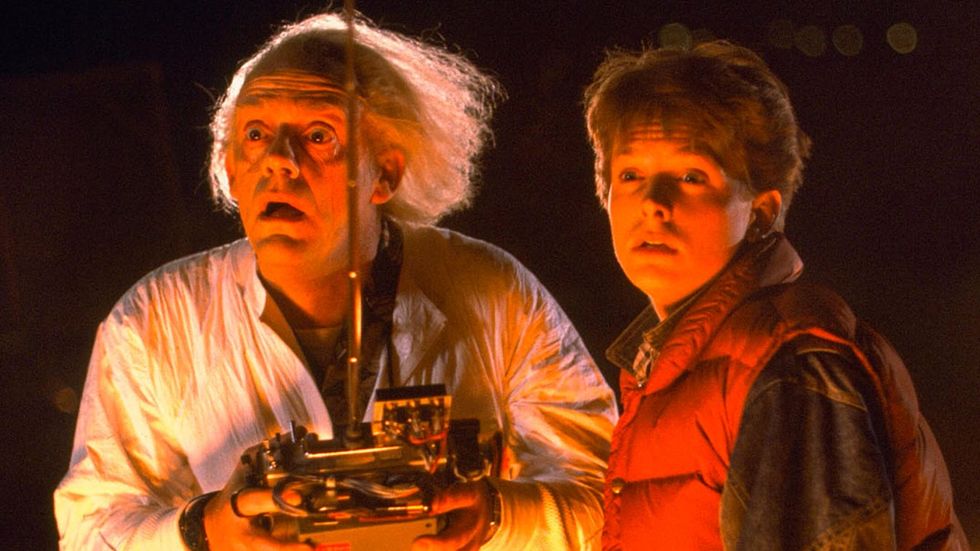The reckless and inquisitive side of me wants to go back in time—not only to ride on the back of a tyrannosaurus and visit the Library of Alexandria (despite not being able to read any of the scrolls)—just to see how it would affect the future. Like countless people, I want to know how time functions, whether it’s a variable that can be altered (like The Sound of Thunder) or if it’s a constant that forms a paradox (like Harry Potter and the Prisoner of Azkaban).
The science behind time travel in the Back to the Future isn’t as convoluted as, say, Doctor Who, but it sure created one of the complicated film series of all time.
Back to the Future (1985)
Roads? Where we’re going, we don’t need roads. ~ Doc Brown
The beauty of the first Back to the Future is that it begins from a place of innocence. Marty McFly feels like any normal teenager living in suburbia—he rides his skateboard, sneaks into school late, and feels the burning weight of exasperation toward/from his parents. When Marty’s entire life (past, present, and future) takes a dramatic jump when he time travels in Doc Brown’s DeLorean, his panic at being stuck in the past and his own mother’s affections feels like a genuine reaction. Sure, we can laugh at the absurdity of the situation from the comfort of our homes, but there’s a part in everyone that wonders what their parents were like as teenagers. (Not to say everyone would want to see that.)
With every “Great Scott!” and product placement, Back to the Future sweeps the audience away with charm and comedic timing. It’s hard not to root for the characters because they have something worth rooting for—George to punch Biff in the nose, Marty to be a trendsetter in rock & roll guitar, and Doc Brown to cheat death with a little bit of foresight.
Rating: A- | 3½ stars
Back to the Future Part II (1989)
Cubs win world series… against Miami? ~ Marty
The art to winning a long-distance race is endurance and pacing. Even Olympic athletes burn out at the start and fade into the back as the race wears on. If the Back to the Future series was an Olympic event, it’s as if a runner thought they were competing in the 100-metre when they were actually in the 1500-metre.
In other words, the original film put the franchise off to a fast start (88 mph fast), but the sequels couldn’t carry the momentum.
I knew Part II was headed down a bleak wormhole when I realized Biff was going to be the antagonist. Again. Biff fulfilled his function in the first film as the local high school bully/rapist, but Robert Zemeckis did himself an injustice when he thought he could simply recycle the same conflict. Whether it’s 1955, 1985 (alternate “present”), or 2015, Biff does not have any motivations or interesting personality to be passed off as a discount Bond villain.
In fact, every character feels like a mockery to the original film, betray the comedic charm and descending into caricatures rather than intelligent human beings. Jokes and even whole scenes—a hoverboard chase instead of a skateboard—are rehashed. While the 2015 timeline is visually fascinating and fun to snicker at how far we are from flying cars, the rest of Part II feels like it’s trying to suffocate the original to death.
Rating: D+ | 1 star
Back to the Future Part III (1990)
I hate manure. ~ Buford Tannen
Part III continues the problems of Part II—only setting it in the Wild West. It’s as corny as it sounds, and if the cast’s half-hearted acting is any indication, they knew it too.
In this one, Marty travels back to 1885 to rescue Doc Brown from certain death, which eventually leads to him meeting his own ancestor (Seamus) and getting in a shootout with Biff’s ancestor (Buford). The moral from this thrice-fold conflict: all of humanity is doomed to a horrifying genetic loop, cursed to be exact replicas of our ancestors and never expand our lives beyond childhood.
At least the film attempts something new by introducing Clara Clayton, a schoolteacher with an uncomfortable infatuation with her 40-years-older savior Doc Brown. However, she too falls into the same trap that it seems all women are victims, which is to be an obstacle to Marty and Doc Brown arriving home safely. Clara boards a moving train in heels and a poufy purple dress (impressive), but almost gets her head run over by the train (less impressive) before being saved by Doc Brown on a hoverboard.
Rating: F | 0 stars
Final Comment
It’s discouraging to think that Zemeckis could follow up Back to the Future with what feels like two half-hour TV pilots that got turned into feature-length films. I’ll always love the original, but I wish I could go back to the past before I saw the sequels.















